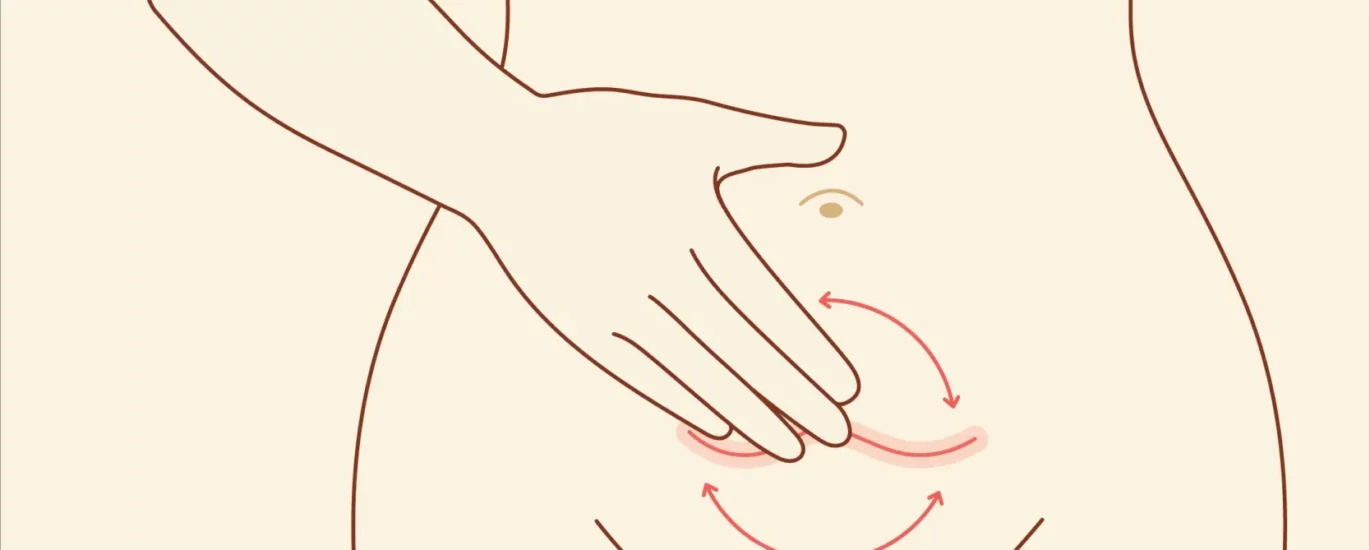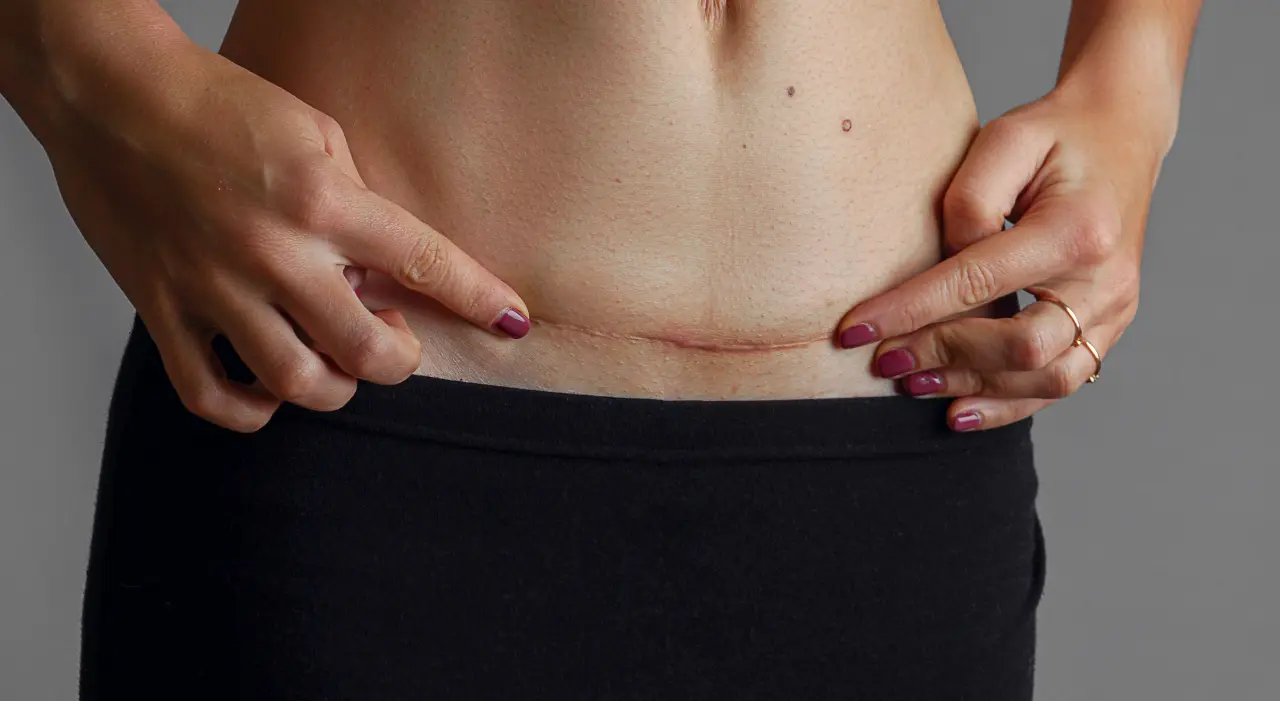

wordpress-seo domain was triggered too early. This is usually an indicator for some code in the plugin or theme running too early. Translations should be loaded at the init action or later. Please see Debugging in WordPress for more information. (This message was added in version 6.7.0.) in /home/sehatnagar.com/public_html/wp-includes/functions.php on line 6114
Burning with strength and rebirth, the C-section scar tells a story of triumph and new beginnings. Cesarean section (C-section) is a surgical procedure performed when a vaginal birth is not possible or safe for the mother or baby. In this case doctors make a small cut in the mother’s belly to take out the baby. C-sections are becoming more common globally, accounting for around 21% of all births according to the World Health Organization. After a C-section, a scar forms at the incision site as part of the healing process. These scars can vary in appearance, from faint lines to raised or thickened scars. However, some women experience challenges due to these scars. One common challenge is physical discomfort. C-section scars can feel tight, itchy, or even painful. Scar tissue may also adhere to the underlying tissues, restricting movement and causing additional discomfort.
C-section scars can also have a psychological impact. Women may feel self-conscious or have concerns about their body image due to these scars, affecting their self-esteem and well-being. This article will explore the concept of C section scar burning as a potential solution for these challenges. Scar burning, also known as scar revision or laser scar treatment, seeks to improve the appearance and reduce discomfort caused by C-section scars. We will provide a comprehensive understanding of C-section scar burning, including its benefits, risks, and alternative approaches to scar management. We will also discuss various aspects of C-section scar burning, share insights from experts, present patient experiences, and provide guidance on finding a qualified professional for safe and effective treatment.
C-section scars form as a natural part of the healing process after the surgical procedure. During a C-section, an incision is made in the mother’s abdomen and uterus to deliver the baby. The incision is typically made horizontally just above the pubic hairline, but in some cases, a vertical incision may be necessary. After the incision is closed, the body initiates the healing process. Initially, the incision site will develop an inflammation response, and over time, collagen fibers start to form. These fibers help to close and repair the wound, eventually leading to the formation of a scar.
The type of scar that develops can vary based on factors such as genetics, skin type, and the healing process of each individual. Some women may have scars that are thin and barely noticeable, while others may develop raised, thickened scars or keloid scars, which extend beyond the boundaries of the original incision.
C-section scars can give rise to various challenges and discomfort for women. One common issue is pain or discomfort around the scar area. The scar tissue may feel tight, leading to sensations of pulling or tugging. This discomfort can be exacerbated during movements that stretch the abdominal area. Sensitivity is another common issue. The scar and surrounding tissues may become more sensitive than the unaffected skin. Women may experience heightened sensitivity to touch or pressure, which can cause discomfort or pain.
Itching is also a frequent complaint associated with C-section scars. It can be attributed to the healing process and the formation of new skin cells. The itching sensation can be bothersome and can sometimes lead to scratching, which may potentially irritate the scar further.
C-section scars can have a significant psychological impact on women. Some may feel self-conscious about their scars and worry about how others perceive them. Body image concerns may arise due to the visible reminder of the surgical procedure, potentially affecting self-esteem and confidence. The emotional impact of C-section scars can be influenced by societal expectations and cultural attitudes towards postpartum bodies. Women may compare themselves to unrealistic ideals or feel pressure to conform to certain beauty standards, which can further exacerbate their body image concerns.
Additionally, the adjustment to the physical changes brought about by pregnancy and childbirth can already be challenging for many women. C-section scars may serve as a constant reminder of the birth experience, triggering emotional responses and potentially impacting overall well-being.
C-section scar burning, also known as scar revision or laser scar treatment, is a medical procedure aimed at improving the appearance and reducing discomfort associated with C-section scars. It involves using various techniques, such as laser therapy, to target the scar tissue and promote healing.
The primary goal of C-section scar burning is to minimize the visibility of the scar by breaking down excessive scar tissue, stimulating collagen production, and encouraging healthy skin regeneration. This can result in a smoother, flatter scar that blends more seamlessly with the surrounding skin.
Read Also: Burn Scars: Causes, Treatment, And Care
Several techniques can be employed during C-section scar burning procedures. One commonly used method is laser therapy, which involves using a focused beam of light to target the scar tissue. The laser energy is absorbed by the scar tissue, causing it to break down and stimulating the production of new collagen. Another technique that may be used is microdermabrasion, where a device with a rough surface is used to gently exfoliate the scarred skin. This helps to remove the top layer of dead skin cells, promoting new cell growth and improving the overall texture of the scar.
In some cases, chemical peels may be utilized to reduce the appearance of C-section scars. Chemical solutions are applied to the scarred area, causing the outer layer of skin to peel off. This process stimulates new skin growth, leading to a smoother and more even skin surface. The specific technique used in scar burning procedures may vary depending on the individual’s scar characteristics, their skin type, and the recommendations of the doctor performing the procedure.
C-section scar burning offers several potential benefits for individuals seeking to address the challenges associated with their scars:

While scar burning procedures can offer benefits, it is essential to be aware of potential risks and complications:
Non-invasive scar management techniques offer alternative ways to address C-section scars without resorting to surgical interventions. These methods focus on minimizing the visibility and improving the texture of scars. Some common non-invasive techniques include the use of silicone sheets or gels, scar massage, and compression garments. Silicone sheets or gels create a protective barrier over the scar, helping to flatten and soften it over time. Scar massage involves gently massaging the scar area to break down scar tissue and improve blood circulation, promoting scar healing. Compression garments, such as abdominal binders or support garments, provide consistent pressure to the scar area, aiding in scar flattening and reducing visibility.
Some common non-invasive techniques include:
Natural remedies and topical treatments are also explored as alternative approaches to scar reduction. While their efficacy may vary and scientific evidence supporting their use can be limited, some individuals find them beneficial. Aloe vera gel, known for its soothing properties, is believed to aid in scar healing by reducing inflammation and promoting skin regeneration. Vitamin E oil or creams, although studies have shown mixed results, are sometimes used topically to improve scar appearance by moisturizing the skin and promoting healing. Some topical products containing onion extract, believed to have anti-inflammatory and scar-reducing properties, may also be used to improve scar appearance. Some examples include:
Most of the time we have received a similar kind of query “My c section scar is burning“.
Experiencing a burning sensation around your C-section scar can happen due to a few reasons. Firstly, as the scar heals, the nerves in the surrounding area may start to regenerate, causing heightened sensitivity and unusual sensations, including a burning feeling. This is a normal part of the healing process and should gradually improve over time. Secondly, the formation of scar tissue during the healing process can sometimes lead to irritation and discomfort, resulting in a burning sensation. This is more likely if the scar tissue becomes thick or raised.
It’s also important to consider the possibility of infection. If you notice redness, swelling, increased pain, discharge, or have a fever, it could indicate an infection. Certain skin conditions like dermatitis or eczema can also affect the skin around the C-section scar and cause burning or itching sensations. These conditions may require specific medical management. Additionally, scar adhesions, which are bands of scar tissue that form between layers of tissue, can cause discomfort and pulling sensations, including a burning feeling. If you experience significant pain or restricted movement due to scar adhesions, it is advisable to seek medical attention.
If you are continuously experiencing intense or prolonged burning sensations around your C-section scar, it is recommended to consult with a doctor as he can assist you batter.
Experiencing a burning sensation around a C-section scar is not uncommon and can occur during different stages of the healing process. Here’s a breakdown of how the burning sensation might progress over time:
During the first week after the C-section surgery, it is typical to feel some discomfort and tenderness around the incision site. It is common to experience a burning sensation as the nerves in the area begin to regenerate. The scar tissue is still in the early stages of formation, and the healing process is ongoing. It’s important to follow proper wound care instructions provided by your healthcare provider to aid in the healing process and alleviate any discomfort.
By the second week, the burning sensation around the C-section scar should gradually diminish. The scar tissue continues to mature, and the nerve regeneration process progresses. However, it is possible to still experience occasional bouts of mild burning or sensitivity, particularly if there is friction or pressure on the scar area. It’s essential to continue practicing good scar care and maintaining cleanliness to support the healing process.
At this stage, the burning sensation around the C-section scar should be minimal or absent in most cases. The scar tissue continues to remodel, and the nerve endings in the area should settle down, resulting in reduced sensitivity. However, individual healing rates may vary, and some individuals may still experience occasional mild burning sensations. It is important to be patient and give your body adequate time to heal fully.
It’s important to note that if the burning sensation worsens, becomes severe, or is accompanied by other concerning symptoms such as excessive redness, swelling, discharge, or fever, it may indicate an infection or another complication.
Experiencing a burning sensation in the C-section scar during pregnancy can be disconcerting. While it is not uncommon for pregnant individuals to feel discomfort or sensations around the scar area, the burning sensation should still be evaluated by a healthcare professional to ensure there are no underlying issues. Here are some possible reasons for a burning sensation in the C-section scar during pregnancy:
In conclusion, C-section scars can sometimes cause a burning sensation, which can be attributed to factors such as nerve regeneration, scar tissue formation, or skin conditions. It is essential to consult a healthcare professional if the burning sensation is persistent or severe. Alternative approaches to scar management, such as non-invasive techniques and natural remedies, can provide potential benefits in reducing pain and improving scar appearance. However, it is crucial to seek professional advice before trying these methods. Furthermore, individualized treatment plans and guidance from healthcare professionals are crucial for effective scar management. They can monitor progress, address complications, and provide appropriate interventions.
Read Also: Weight Loss After C Section: Strategies And Tips For New Mothers